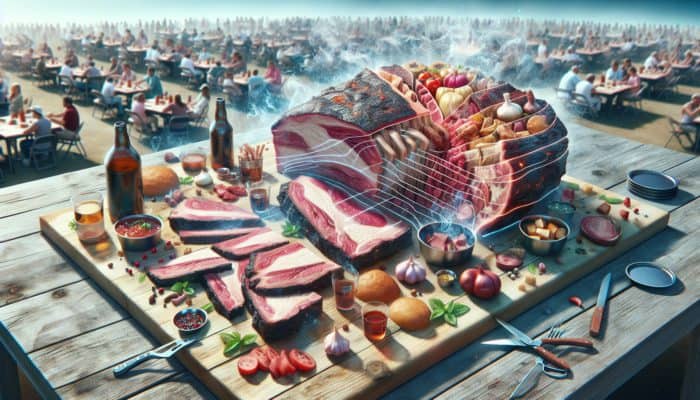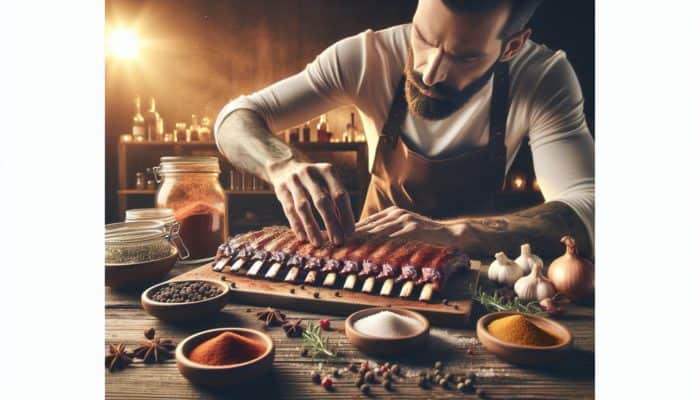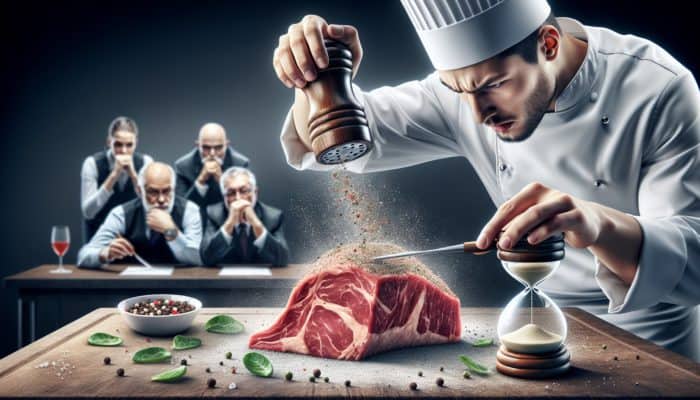Enhance Your BBQ Skills by Selecting the Ideal Cuts of Meat for Competition Success
Choosing the right cuts of meat is essential for achieving remarkable results in any BBQ competition. Many competitors make the critical error of confusing the various cuts and their specific cooking methods. Selecting a cut that doesn't suit your cooking style can lead to mediocre results. Therefore, it is crucial to understand which cuts are best suited for different BBQ techniques. This knowledge is indispensable for crafting a mouth-watering dish that will not only impress the judges but also significantly enhance your chances of clinching victory.
Explore Different Meat Cuts to Strengthen Your BBQ Competition Strategy

In the highly competitive realm of BBQ, understanding the unique characteristics of various meat cuts is paramount. For instance, using tougher cuts such as brisket without proper techniques can result in disappointing dishes. Brisket necessitates a prolonged cooking time and specialised methods, including low-and-slow smoking, to effectively break down the tough connective tissues. If these cuts are not prepared correctly, the outcome may be a tough, chewy dish that judges will undoubtedly frown upon. Additionally, mastering the art of fat trimming and knowing how much to retain can significantly elevate the flavour and tenderness of your meat, enhancing the overall dish.
Another frequent mistake is opting for cuts that have been overly processed or pre-seasoned. Many competitors mistakenly assume that using pre-marinated or seasoned cuts saves time; however, this often results in inconsistent flavour profiles and textures. Judges appreciate the skill involved in preparing and seasoning fresh cuts from scratch, as this not only showcases your culinary expertise but also ensures that the flavour aligns perfectly with your vision for the dish.
Moreover, the source of your meat is pivotal to your success in competitions. Numerous BBQ contests occur in areas with distinct preferences for specific cuts. For instance, brisket is a staple in Texas, while Kansas City often showcases pork ribs. Being aware of these regional tastes can provide you with a competitive edge, enabling you to select cuts that resonate with local judges and attendees, thereby significantly improving your chances of success.
Prioritise High-Quality Meat for Outstanding BBQ Competition Results
In the high-pressure environment of BBQ competitions, the quality of your meat is undeniably crucial. Using inferior-quality meat can severely compromise flavour and tenderness, two critical factors in the judging process. Judges will closely assess the meat’s ability to retain moisture during cooking. Poor-quality meat often results in dryness, a sure way to receive lacklustre scores. Therefore, investing in high-quality meat is essential for achieving superior flavour and texture, leading to a more enjoyable experience for the judges and a better likelihood of success.
Opting for premium cuts, such as certified Angus beef, can dramatically enhance the overall appeal of your dish. The marbling found in high-quality meat amplifies its flavour and juiciness, setting it apart from lower-grade options. Presenting a dish crafted from top-tier meat not only reflects your dedication to the BBQ craft but also significantly increases your chances of impressing the judges with your culinary offerings.
Additionally, ensuring the freshness of your meat is of utmost importance. Selecting meat that has been frozen or stored for long periods can lead to a decline in quality. Ideally, you should source your meat from local butchers or farms with a reputation for high standards. This approach not only guarantees freshness but also supports local businesses, which can resonate positively with the audience during the competition.
Choose a Reliable Supplier for Your BBQ Meat Needs
The origin of your meat is just as significant as the cut and quality. Sourcing meat from unreliable suppliers can result in inconsistent quality, adversely affecting your competition performance. Consistency is vital in BBQ competitions; if you practice with meat from one supplier and then switch to another, you may be surprised by the differences in how the meat cooks. Such inconsistencies can shake your confidence during the competition, potentially impacting your overall performance.
Furthermore, understanding the source of your meat provides valuable insights into its flavour profile. Certain regions are renowned for specific breeds or types of meat that possess distinct taste characteristics. For example, pork from heritage breeds can deliver a richness of flavour that standard supermarket options simply cannot match.
Additionally, many competitions offer networking opportunities with suppliers and farms. Engaging with these connections can enhance your current performance while paving the way for future success in upcoming events. The relationships you build may lead to sponsorship opportunities or preferential access to premium cuts, giving you a competitive advantage in future contests.
Refine Your Seasoning Techniques for BBQ Excellence

Mastering your seasoning techniques is crucial for achieving exceptional results in BBQ competitions. One of the most frequent pitfalls in BBQ competitions is failing to establish a balanced flavour profile, which is essential for impressing discerning judges.
Achieve Flavour Harmony: Avoid Over-Seasoning Your BBQ Creations
A significant mistake that many competitors make is over-seasoning their meat. Applying too much seasoning can easily overshadow the meat's natural flavours, which is a common error in BBQ contests. Judges look for a balanced interplay between seasoning and the meat's inherent taste. An overly aggressive approach can turn a dish into a salt lick rather than a carefully crafted BBQ masterpiece.
To circumvent this issue, start with a light touch when applying rubs or marinades. Remember, seasoning should enhance the natural flavours, not obscure them. Begin with a base of salt and pepper, then gradually layer in additional spices to create complexity without overwhelming the palate. This balanced method allows judges to appreciate the depth of flavours and the quality of the meat itself.
Furthermore, conducting pre-competition taste tests on your seasoning can be immensely beneficial. Invite friends or family to sample your dish and provide candid feedback. This practice can help you assess whether your flavours are on point or if adjustments are necessary, ultimately enhancing your final product and increasing your chances of success.
Elevate Flavour Profiles by Avoiding Under-Seasoning
Conversely, under-seasoning is another common issue that can lead to disappointing outcomes. Insufficient seasoning can result in bland flavours, which judges often penalise. They expect a well-rounded flavour profile that showcases your skills as a pitmaster, and neglecting to season adequately can leave them unimpressed and disappointed.
Achieving the right seasoning balance requires both knowledge of flavours and confidence in your ability to enhance them. Experimenting with various spice blends and marinades before the competition can provide valuable insights into what works best for you. A well-executed seasoning strategy can elevate your dish from ordinary to extraordinary, leaving a memorable impression on the judges.
It's also crucial to consider the specific flavour preferences of the judges at your competition. Some may favour a sweeter profile, while others might prefer spicier or more savoury flavours. Understanding these preferences can help you tailor your seasoning approach to resonate with the judges, significantly increasing your chances of success.
Ensure Consistent Seasoning Application for Maximum Impact

Inconsistent seasoning application can lead to uneven flavour distribution throughout the meat, ultimately affecting your scores negatively. Judges are meticulous and will easily spot any discrepancies in taste. A bite that is heavily seasoned compared to another that is bland can create a disjointed experience that detracts from the overall impression of your dish.
To mitigate this issue, ensure that you apply your seasoning uniformly. Using a shaker or similar tool can facilitate even distribution. Additionally, allowing the meat to rest after applying the seasoning enables the flavours to penetrate and meld together. This resting period ensures that the meat absorbs the seasoning, resulting in a more cohesive flavour profile that judges will appreciate.
Practice is also essential for refining your seasoning technique. As you prepare for competitions, pay close attention to how you apply your seasonings and strive for consistency in each batch you cook. Establishing a standard operating procedure for your seasoning process can minimise errors and enhance your confidence on competition day, thereby setting you up for success.
Master Cooking Temperatures for BBQ Mastery
Understanding cooking temperatures is a vital aspect of BBQ success, and errors in this area are among the top mistakes to avoid in BBQ competitions. Incorrect cooking temperatures can lead to undercooked or overcooked meat, disappointing judges who expect perfectly executed dishes that showcase your skills.
Avoid Over-Cooking: The Dangers of High Heat Cooking Techniques
Cooking at excessively high temperatures can result in a charred exterior while leaving the interior undercooked. This creates a dish that may look visually appealing on the outside but is raw or improperly cooked on the inside. Judges will quickly recognise such inconsistencies, which can significantly detract from your scores.
For example, BBQ brisket is optimally cooked at temperatures ranging from 225°F to 250°F. This low-and-slow technique allows the meat to render fat and break down collagen, resulting in tender and flavourful outcomes. Many competitors mistakenly increase the heat to speed up the cooking process, but this often leads to dry and tough cuts that fail to impress the judges.
Utilising a reliable smoker or grill equipped with accurate temperature controls can assist in maintaining the correct cooking temperatures. Investing in a quality thermometer ensures that you can accurately monitor internal temperatures, allowing for perfectly cooked meat and a heightened likelihood of winning over the judges with your culinary prowess.
Prevent Undercooking: Uphold Low Heat Standards
Conversely, cooking at excessively low temperatures can also lead to undercooked meat, a significant concern in competitions. Undercooked meat not only represents a culinary misstep; it can also pose health risks. Judges may disqualify entries that do not meet food safety standards, resulting in lost opportunities for success.
Identifying the optimal cooking temperature is essential. While different meats require varying approaches, understanding the appropriate temperature for each type is crucial. For instance, pork must reach an internal temperature of 145°F, while chicken should be cooked to at least 165°F. Familiarising yourself with these benchmarks ensures that you consistently deliver perfectly cooked entries that meet competition standards.
To further guard against undercooking, consider employing a dual-probe thermometer. This tool allows you to monitor both internal and external temperatures without frequently opening the grill or smoker, helping to preserve heat and ensure even cooking throughout the meat.
Manage Temperature Fluctuations for Consistent BBQ Results
Inconsistent cooking temperatures can lead to uneven cooking, compromising the quality of the final product. Fluctuations in heat can arise from various factors, including wind, humidity, or even the amount of fuel used during the cooking process. Judges are acutely aware of these subtleties; if they detect uneven cooking, it could negatively reflect on your skills as a pitmaster.
To counteract temperature fluctuations, consider implementing a shield or windbreak if cooking outdoors. Reducing exposure to external elements can assist in maintaining stable cooking temperatures. Additionally, ensure that your fuel source—whether charcoal, wood, or gas—is consistently supplying the necessary heat to uphold even temperatures throughout the cooking process.
Diligently monitoring your cooking progress will also help you identify any issues quickly. If you notice an unexpected drop in temperature, you can make adjustments before it adversely affects the meat. Familiarity with your equipment will provide insights into its performance under different conditions, enabling you to adapt as necessary on competition day.
Utilise Accurate Temperature Monitoring for BBQ Success
Neglecting to use a thermometer can lead to guesswork in cooking, resulting in inconsistent and potentially unsafe meat temperatures. The old adage “when in doubt, throw it out” is particularly relevant in BBQ competitions. Judges prioritise food safety, and failing to adhere to appropriate temperature standards can lead to disqualification.
Investing in a reliable thermometer is a critical step in preparing for competitions. Whether you choose a digital or analogue thermometer, a quality device will help ensure that your meat is cooked to the recommended temperatures. Regularly checking the internal temperature of your meat will not only yield tender and juicy outcomes but also keep you compliant with food safety standards essential for competition success.
Additionally, keep in mind that different cuts of meat may require varying internal temperatures. Thus, understanding the specifics of each cut you plan to cook will empower you to master your cooking strategy and improve your chances of success on competition day.
Master Smoke Management for Delicious BBQ Results
Smoke is a fundamental element of BBQ, but poor smoke management can lead to critical mistakes in BBQ competitions. Knowing how to manage smoke effectively is vital for producing flavourful dishes that captivate judges and elevate your BBQ performance to new heights.
Select the Right Wood Types for Enhanced Flavours in Your BBQ Dishes
Choosing inappropriate wood types can impart undesirable flavours to your meat. Each type of wood contributes its own unique flavour characteristics; for example, mesquite offers a bold, robust smoke flavour, while fruitwoods like apple or cherry provide a milder, sweeter profile. Using the wrong type of wood can easily overshadow the natural taste of the meat, resulting in an unbalanced dish that fails to impress.
When selecting wood, consider the type of meat you're cooking. For instance, hickory is often preferred for pork, while cherry wood beautifully complements chicken. Moreover, some wood types may be better suited for specific cooking methods. If you're using a grill, opt for chunks of wood rather than chips to prevent them from burning too quickly and losing their flavour.
Understanding the moisture content of the wood is also crucial. Fresh or “green” wood can produce excessive smoke, while well-seasoned wood burns cleanly. Paying attention to this detail can make the difference between a flavour-rich entry and one that falls flat, impacting your overall competition success.
Avoid Over-Smoking: Striking the Perfect Flavour Balance
Excessive smoke can overwhelm the meat's flavour, a common mistake encountered in BBQ contests. Judges look for a well-balanced flavour that enhances the meat without masking it. Over-smoking not only detracts from the dish's integrity but can also leave a bitter aftertaste that judges won't easily forget.
To achieve the perfect balance, limit the amount of wood used. Start with a small quantity and gradually add more to assess smoke levels. Additionally, the type of cooker or smoker you utilise can influence smoke intensity, so some models may require experimentation to find the right balance.
Incorporating a smoke box or adding wood towards the end of cooking can enhance flavour without overwhelming the dish. Finally, consider the total cooking time; longer cook durations may necessitate less frequent wood addition to avoid overpowering smoke flavours that can detract from your dish.
Ensure Proper Ventilation for Clean Smoke Production
Poor ventilation can lead to bitter flavours resulting from creosote buildup, which judges will undoubtedly notice. Ensuring proper airflow during cooking is essential for producing clean smoke that enhances the meat's flavour and overall appeal.
Most smokers are equipped with adjustable vents, which should be utilised effectively. Opening vents allows fresh air to flow in, promoting clean combustion and ensuring that any smoke produced is flavourful rather than bitter. Regularly checking and adjusting vents based on cooking temperature can help maintain optimal conditions for your BBQ.
Monitoring the amount of smoke produced during cooking is also vital. Thin, blue smoke indicates efficient combustion, while thick, white smoke suggests your meat may absorb undesirable flavours. Mastering smoke and ventilation management can be a game-changer in achieving high scores in BBQ competitions, showcasing your skills as a pitmaster.
Implement Effective Time Management Strategies in BBQ Competitions
Time management is a critical element when competing in BBQ contests. Among the most common mistakes to avoid in BBQ competitions is underestimating the time required for cooking, resting, and presentation, which can lead to subpar results and missed opportunities.
Calculate Adequate Cooking Time to Perfect Your BBQ
Failing to allocate sufficient time for cooking can result in rushed and undercooked entries. BBQ is an art that requires both time and patience. Each cut of meat has its ideal cooking timeframe, and understanding these nuances is crucial for achieving optimal results.
Many novice competitors underestimate how long different types of meat will take to cook. For example, a whole hog may require up to 24 hours, while ribs can be ready in half that time. Creating a detailed timeline that encompasses preparation, cooking, and resting times will help ensure you can execute your plan effectively and avoid last-minute scrambles that jeopardise your entries.
Moreover, cooking times can fluctuate based on environmental conditions and the type of equipment used. Building buffer time into your cooking timeline is essential; this not only prevents the risk of presenting undercooked entries but also provides flexibility to accommodate unforeseen delays, ultimately enhancing your competition experience and outcomes.
Incorporate Resting Time to Enhance Flavour and Texture
Neglecting to allow meat to rest can lead to significant juice loss, adversely impacting taste and texture. Resting time is vital for redistributing juices throughout the meat, resulting in a more flavourful and moist final product that impresses judges and elevates your score.
The ideal resting time varies depending on the cut of meat; larger cuts such as brisket may require at least 30 minutes, while smaller cuts like chicken may only need approximately 10-15 minutes. Be sure to factor resting periods into your timeline to ensure your final dish reaches its full potential and delights the judges.
Taking the time to rest your meat also allows you to focus on finishing touches, such as sauce application or plating. This attention to detail ensures that your presentation is as impressive as the flavour, further enhancing your chances of success in the competition.
Avoid Late Submissions: Emphasise Timeliness in Competitions
Submitting entries late can lead to disqualification, a critical error to avoid in BBQ competitions. Most contests operate on strict timelines, and being tardy can mean the difference between winning and losing.
To combat this issue, plan for potential setbacks and delays in your timeline. Aim to have everything prepared well in advance of the submission deadline. By building in extra time for each step of the process, you can help ensure that there are no last-minute scrambles that jeopardise your entry and overall performance.
Additionally, familiarise yourself with the competition schedule and specific submission requirements. Understanding these timelines can help you strategise effectively and avoid penalties for tardiness, ultimately contributing to your overall performance and success.
Enhance Your Presentation Skills for BBQ Competitions
In BBQ competitions, presentation is of utmost importance, and neglecting this aspect can result in disappointing scores. Among the most significant mistakes to avoid in BBQ competitions is overlooking the visual appeal of your dish, which can significantly influence judges' perceptions and evaluations.
Boost Aesthetic Appeal for Positive First Impressions
Failing to prioritise visual appeal can negatively impact judges' first impressions. Presentation plays a crucial role in the judging process; a beautifully presented dish can set the stage for a favourable evaluation and enhance your chances of scoring high.
Elements such as vibrant colours, artistic arrangement, and thoughtful garnishing all contribute to how a dish is perceived. For instance, utilising bright garnishes like fresh herbs or colourful vegetables can catch the eye and create an inviting plate that appeals to the senses even before the first bite is taken.
Moreover, consider how the dish appears on the serving platter. Using contrasting colours can make the meat stand out, while plating techniques that highlight the meat's texture can enhance perceived quality. Judges are not just tasting the food; they are also interpreting the level of care taken in the dish's presentation, which can significantly impact their scoring.
Strategic Garnishing to Elevate Your Presentation
Inappropriate or careless garnishing can detract from the overall presentation of your dish. Garnishes should complement the dish rather than overpower it. Simple, elegant touches can enhance your dish without overwhelming the judges or detracting from the main components.
When garnishing, it’s wise to adhere to a theme that aligns with the dish's flavours. For example, if your BBQ sauce has a sweet profile, consider garnishing with fresh fruit or a drizzle of a complementary sauce. Keeping garnishes fresh and free from wilting is essential, as judges will notice any signs of neglect that can adversely affect their overall impression.
Placing garnishes strategically can also enhance visual appeal. Rather than overcrowding the plate, focus on balance and simplicity, allowing the main components to shine. Judges appreciate a well-thought-out presentation that showcases your culinary skills and attention to detail, which can make a lasting impression.
Maintain Neatness in Serving for Positive Impressions
Serving meat in a messy manner can detract from scores, even if the taste is exceptional. Judges expect a neat, deliberate presentation that highlights your culinary skills. If the meat is carelessly placed on the plate or presented unappealingly, it can create a negative impression from the outset.
To maintain cleanliness, utilise appropriate serving utensils and ensure that every component is placed with intention. Consider how your dish is arranged to showcase textures and flavours. Taking the time to wipe down any drips or spills on the plate before presentation can significantly enhance the overall impression of your dish, allowing you to present your best work.
Additionally, practising your presentation skills ahead of the competition will enhance your confidence and improve the overall appearance of your dish. Familiarising yourself with plating techniques can elevate the visual appeal and impress judges, which is vital for achieving high scores and recognition.
The Essential Role of Consistent Practice for BBQ Competition Triumph
The saying “practice makes perfect” holds especially true in BBQ competitions. A common source of failure is insufficient rehearsals, which can lead to unforeseen challenges on competition day that may undermine your efforts.
Establish Comprehensive Rehearsals for Optimal BBQ Success
Not practising enough can result in unexpected issues during the actual competition. The intricacies of BBQ cooking require hands-on experience to master. Each cooking method and cut of meat presents unique challenges, and rehearsing can help you navigate these hurdles effectively and confidently.
Conducting multiple practice runs allows you to refine your skills, experiment with different techniques, and identify areas for improvement. For instance, you may discover that your initial cooking times were inadequate or that your seasoning method requires adjustment to meet your desired flavour profile.
Furthermore, practising under varied conditions—such as different weather, equipment, or cooking distractions—can help prepare you for the unpredictability of competition day. The more rehearsed you are, the more confidently you can approach the event, thereby increasing your chances of success.
Embrace Feedback for Continuous Improvement in Your BBQ Skills
Neglecting to consider feedback from previous competitions can hinder your growth as a competitor. Constructive criticism, whether from judges or fellow competitors, can offer invaluable insights that enhance your BBQ skills and performance.
Take the time to analyse judges’ comments and reviews of your previous entries. Identify consistent themes or criticisms, and utilise this information to make necessary adjustments. This proactive approach to feedback can elevate your BBQ game and lead to better outcomes in future competitions.
Seeking feedback from friends or family during practice runs can also illuminate areas for growth. Cultivating a mindset that welcomes critique and views it as a tool for improvement is essential for continuous development in your BBQ journey.
Simulate Competition Conditions for Realistic Practice
Practising under different conditions can lead to surprises on competition day. If you typically practice in a controlled setting, you may find yourself unprepared for the realities of a competition environment, where distractions, weather changes, and time constraints can arise.
To combat this, try to replicate competition conditions as closely as possible during practice sessions. Establish strict timelines, use the same equipment you’ll utilise in the competition, and even recruit friends or family to act as mock judges. This approach creates a more realistic environment that prepares you for the challenges you will face on competition day.
Additionally, consider practising your entire timeline—from preparation to presentation—to identify any areas of concern. This thorough preparation will bolster your confidence and enhance your performance at the competition, enabling you to effectively showcase your BBQ skills and expertise.
Understand and Adhere to BBQ Competition Rules for Success
Finally, comprehending competition rules is vital for achieving success in BBQ contests. Among the most significant mistakes to avoid in BBQ competitions is failing to adhere to guidelines governing categories, conflicts of interest, and time limits, which can jeopardise your chances of success.
Clarify Category Requirements for BBQ Competitions
Categories in BBQ competitions can vary widely, and misunderstanding them can result in disqualification or penalties. It’s essential to thoroughly read and comprehend competition rules before entering. Each category may have specific requirements regarding the type and presentation of the meat, and failing to follow these can undermine your hard work and preparation.
If the competition features distinct categories, such as ribs, brisket, or chicken, ensure you are well-versed in the requirements of each. Some competitions may even have subcategories based on cooking methods or sauces, so being familiar with these nuances can provide you with a competitive advantage and increase your chances of success.
A seasoned competitor will attest that understanding the particulars of each category can significantly enhance your chances of success. Tailoring your preparation to align with these guidelines will give you the best opportunity to impress the judges and secure high scores.
Declare Conflicts of Interest to Maintain Integrity in Competitions
Failing to disclose relationships or interests that could influence competition outcomes can lead to disqualification or penalties. Most competitions have strict guidelines regarding conflicts of interest, and overlooking this aspect can jeopardise your chances of success.
It’s crucial to be transparent about any affiliations you may have with sponsors, judges, or other competitors. By being upfront, you protect yourself from potential fallout and maintain your integrity within the competition environment.
Moreover, this transparency fosters trust within the BBQ community. Competing with honesty and integrity not only enhances your reputation but can also lead to future collaboration or sponsorship opportunities, enriching your BBQ journey and experience.
Adhere to Time Limits for Successful Competition Outcomes
Exceeding allotted times for submissions or performances can lead to point deductions or disqualification from the competition. Each BBQ competition has specific timelines, and adherence is crucial for maintaining a favourable standing.
To avoid this pitfall, familiarise yourself with the competition schedule and set strict deadlines for your preparations. Create a detailed timeline for all aspects of your process and commit to it.
Planning for potential setbacks is critical, but maintaining a sense of urgency is equally important. The more disciplined you are in managing your time, the better your chances of impressing the judges and executing a successful BBQ entry that showcases your skills and dedication.
Frequently Asked Questions about BBQ Competitions
Which cuts of meat excel in BBQ competitions?
The best cut often depends on the category, but brisket, pork ribs, and chicken thighs are popular choices. Understanding the nuances of each cut is crucial for success in competitions.
How crucial is seasoning in BBQ competitions?
Seasoning is vital as it enhances the meat's natural flavours. A well-seasoned dish can significantly improve your chances of scoring high with judges, showcasing your skills as a proficient pitmaster.
What cooking temperature should I aim for when smoking meat?
Generally, a temperature range of 225°F to 250°F is ideal for low-and-slow cooking. This temperature allows for even cooking and tender results, essential for competition success.
How can I prevent over-smoking my meat?
To prevent over-smoking, use a minimal amount of wood and closely monitor smoke levels. Limiting smoking time for delicate meats helps maintain balanced flavours that judges will appreciate.
Why is resting meat important in BBQ competitions?
Resting meat allows juices to redistribute, enhancing flavour and texture. It’s essential for delivering a moist and tender dish that impresses judges and elevates your score.
What should I focus on in my presentation for BBQ competitions?
Prioritise visual appeal, cleanliness, and strategic garnishing. A well-presented dish can positively influence judges’ perceptions and improve your chances of scoring high.
How can I practice effectively for a BBQ competition?
Conduct practice runs that simulate competition conditions, including strict timelines and using the same equipment you'll use on competition day. This preparation will enhance your performance and readiness.
What are common time management mistakes in BBQ competitions?
Common mistakes include underestimating cooking times, overlooking resting periods, and failing to submit entries on time. Strategic planning and preparation are key to avoiding these pitfalls.
How do I choose the right wood for smoking?
Select wood types based on the meat you’re cooking. Strong woods like hickory work well for pork, while fruitwoods complement poultry nicely, enhancing flavour without overpowering the dish.
Why is it important to understand competition rules?
Understanding the rules helps you avoid disqualification and ensures your entries meet the necessary standards for scoring high with judges, providing you with a competitive advantage.
Connect with us on Facebook!
The Article Top BBQ Competition Mistakes to Avoid: Essential Tips appeared first on https://pitmastersarsenal.com
The Article BBQ Competition Mistakes to Avoid: Key Tips for Success Was Found On https://limitsofstrategy.com
The Article BBQ Competition Mistakes: Essential Tips for Success found first on https://electroquench.com

